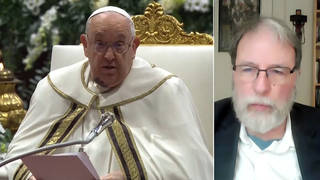
Guests
- Amy Padnanidigital editor of obituaries at The New York Times, who came up with the idea of “Overlooked.”
As the world marked International Women’s Day on Wednesday, The New York Times began a new project highlighting the lives of remarkable women who never had an obituary in the paper, until now. The list might surprise you. It includes the pioneering anti-lynching journalist Ida B. Wells; the writer and poet Sylvia Plath; Qiu Jin, who was known as China’s Joan of Arc; the groundbreaking photographer Diane Arbus; the woman who helped engineer the Brooklyn Bridge, Emily Warren Roebling; Charlotte Brontë, who wrote “Jane Eyre”; Henrietta Lacks, whose cells led to a medical revolution; and Ada Lovelace, who is considered to be the world’s first computer programmer. The New York Times is calling the project “Overlooked,” and it is part of an effort to make up for the paper’s 167-year history of focusing largely on men—mostly white men—in the obituary pages. For more, watch our full interview with Amy Padnani, digital editor of obituaries at The New York Times, who came up with the idea of “Overlooked.”
Transcript
AMY GOODMAN: This is Democracy Now! I’m Amy Goodman. As the world marked International Women’s Day Wednesday, The New York Times began a new project highlighting the lives of remarkable women who never had an obituary in the paper, until now. The list might surprise you. It includes the pioneering anti-lynching journalist Ida B. Wells; the writer, the poet Sylvia Plath; Qiu Jin, who was known as China’s Joan of Arc; the groundbreaking photographer Diane Arbus; the woman who helped engineer the Brooklyn Bridge, Emily Warren Roebling; Charlotte Brontë, who wrote Jane Eyre; Henrietta Lacks, whose cells led to a medical revolution; Ada Lovelace, who is considered to be the world’s first computer programmer. None of their obituaries appeared in the Times. The New York Times is calling their new project “Overlooked.” It’s part of an effort to make up for the paper’s 167-year history of focusing largely on men—overwhelmingly on white men—in the obituary pages.
We’re joined now by Amy Padnani, digital editor of obituaries at The New York Times, who came up with this idea.
Well, the good news, when I read The New York Times obituaries over the years, when I’ve read them, is that it just seemed like women and people of color rarely died.
AMY PADNANI: This was some feedback we frequently got from our readers: “Why don’t we see more women and minorities in your pages?” And that was something that bothered me personally. I just joined obituaries in early 2017. And as you know, the national debate on race was heating up, and the conversation about gender inequality was starting to take hold again. And it really got me thinking, as a woman of color and as an editor at The New York Times, “What can I do to advance this conversation?” All of these people were coming out of the shadows to tell stories of injustices, and it really resonated with me.
So, I came across, in my day-to-day research, a woman who had been credited with bringing tennis to the United States from Bermuda. Her name is Mary Outerbridge. She started the first tennis court on Staten Island, of all places. And I used to live on Staten Island. It’s a place that’s near and dear to my heart. And I thought, “What a neat nugget about history!” So, I checked to see if we had done an obituary on Mary Outerbridge, and we hadn’t. So, I kind of tucked that away in the back of my mind. And through my research, I started coming across more and more names like this. We, as you noted, came across some really surprising ones, like Diane Arbus and Sylvia Plath.
AMY GOODMAN: So let’s talk about who they are.
AMY PADNANI: Sure.
AMY GOODMAN: Diane Arbus.
AMY PADNANI: Sure, the brilliant photographer Diane Arbus. She was known for photographing people kind of on the outskirts of society, sideshow people, dwarfs. Some wondered if she did it for attention, in a way, but others really thought the photos were remarkable and artistic. And she had a lot of fame in her own lifetime, so we were surprised when there was no obituary about her death.
AMY GOODMAN: And Ida B. Wells.
AMY PADNANI: Same, yeah. She was—as you noted, she was a pioneer in the anti-lynching movement and a journalist who was one of the first to produce a newspaper by a black person for black people. And in her lifetime, she also was extremely famous. We even had a little front-page blurb about her marriage, but we didn’t have anything about her death.
AMY GOODMAN: I want to go to my colleague Juan González, who wrote about Ida B. Wells in his book News for All the People: The Epic Story of Race in the American Media. He talked about her on our show when his book came out.
JUAN GONZÁLEZ: Ida B. Wells was one of the early muckrakers, that is not known as a muckraker in the official histories. But in the late 19th century, she was the editor of a paper in Memphis, and three of her friends were lynched by a mob. And she began a crusade against that lynching. And her newspaper was burned down while she was out of town. And she then went across the country, exposing the epidemic of lynching in America of African Americans, and became a really crusading, the first crusading journalist on this issue. And she’s known, again, in the histories of the black press, as one of the giants of the press, but is, again, rarely mentioned or talked about in official histories of the press in America. But she was a key figure, and not only was involved with the NAACP later on, met with presidents over issues of racial discrimination, was a major figure in the late 19th century and early 20th century.
AMY GOODMAN: But her obituary didn’t make it into the Times. What about Sylvia Plath? Tell us who she is.
AMY PADNANI: Sylvia Plath, the famous poet who wrote The Bell Jar, she also was extremely famous in her lifetime. She committed suicide at a fairly young age. And we also—
AMY GOODMAN: In 1963.
AMY PADNANI: That’s right. And we were also really surprised to learn that there was nothing. We had stories about her writing, but we didn’t have an obituary covering her death.
AMY GOODMAN: American poet, American novelist, short story writer, born in Boston. I wanted to go to a clip of Sylvia Plath reading from part of her very famous, painful poem, “Daddy.”
SYLVIA PLATH: You do not do, you do not do
Any more, black shoe
In which I have lived like a foot
For thirty years, poor and white,
Barely daring to breathe or Achoo.
Daddy, I have had to kill you.
You died before I had time—
Marble-heavy, a bag full of God,
Ghastly statue with one gray toe
Big as a Frisco seal
And a head in the freakish Atlantic
Where it pours bean green over blue
In the waters off beautiful Nauset.
I used to pray to recover you.
Ach, du.
AMY GOODMAN: And I want to turn to that documentary, Going Where I’ve Never Been: The Photography of Diane Arbus. In this clip, we hear Arbus’s friend Mary Claire Costello reading Arbus’s musings on photography. Diane Arbus also committed suicide, is that right?
AMY PADNANI: That’s right.
MARY CLAIRE COSTELLO: “If I were just curious, it would be very hard to say to someone, 'I want to come to your house and have you talk to me and tell me the story of your life.' I mean people are going to say, ’You’re crazy.’ Plus they’re going to keep mighty guarded. But the camera is a kind of license. And for a lot of people, they want to be paid that much attention and that’s a reasonable kind of attention to be paid.”
AMY GOODMAN: And that was reading the words of Diane Arbus. Nella Larsen, Amy?
AMY PADNANI: So, Nella Larsen was a literary star during the Harlem Renaissance in the 1920s and 1930s. She wrote a couple of books, that are still discussed in classrooms today, addressing issues of race and pressures that middle-class black families would feel. And when—so, she was accused of plagiarism later on in her life, and she eventually withdrew from the limelight. She died alone in her apartment, and her body was found days later. So she kind of died in obscurity.
AMY GOODMAN: Explain this—I’ve got the section that’s coming out on Sunday. The New York Times, the front page, it’s almost white, but it’s got the photographs leaching through from the inside, of these 15 women, to the outside.
AMY PADNANI: This was a concept we came up with. We wanted it to have that feeling of: These women are no longer overlooked. They’re now coming out of the woodworks. They’re coming out of the shadows, and we’re finally giving them their due.
AMY GOODMAN: What percentage of people in the obituaries are still white men?
AMY PADNANI: About four out of five obits are on white men—are on men.
AMY GOODMAN: What are they?
AMY PADNANI: Sorry, on men. I don’t have the figures for people of color. So, yeah, about 80 percent of our obituaries are about men.
AMY GOODMAN: So, how will this affect the obituaries, going forward?
AMY PADNANI: Well, I’m really hoping that it will help raise awareness and continue the conversation. We also recently hired our very first gender editor, Jessica Bennett, and we have a race-related team. And their goals are to infuse the entire newsroom with a different way of thinking. So, they’re not relegated to this one corner of the newspaper. They’re everywhere. And they’re really tasked with changing the tone, the white male tone of media and of The New York Times, and bringing new perspectives. So, I’m very hopeful that will help with our initiative, too.
AMY GOODMAN: Qiu Jin, can you talk about who she is—she was?
AMY PADNANI: That’s one of my favorite pieces. She was a feminist, a revolutionary in China. She was a poet. And she was a crossdresser. She fought against norms for women. She liked to make bombs. She liked swords. She liked winemaking. She left her family and decided to study. And this is 1906, when she returns to China and engages in an uprising against the government and fought for women. She was eventually executed. But her story is one of the most powerful in that package.
AMY GOODMAN: But didn’t make it into the Times in her day.
AMY PADNANI: It didn’t. We didn’t really have—this is my speculation. We didn’t have as much of an international focus. We often focused largely on New York even, or just the United States.
AMY GOODMAN: How do the decisions get made?
AMY PADNANI: These days, we get submissions from all over—from readers, from social media, from other newspapers, wire services. And every day, we meet, and we look at a list of all the candidates. And we judge based on newsworthiness: Did that person make news in their life? If so, then their death is news, as well. We do a lot of research. We talk to people who knew them. We read old articles, did through our archives. We really do our homework.
AMY GOODMAN: One of The New York Times obits that will appear on Sunday is titled “Marsha P. Johnson: A transgender pioneer and activist who was a fixture of Greenwich Village street life.” I want to turn to Marsha Johnson in her own words. Listen carefully.
MARSHA P. JOHNSON: I learned how to survive, 1963, for better or worse. And I said, “You know, I’ve got the lord on my side,” and I took him in my heart with me, and I came to the city, for better or worse. And he said, “You know you might wind up with nothing,” because, you know, me and Jesus are always talking. And I said, “Honey, I don’t care if I never have nothing ever ’til the day I die. All I want is my freedom.” And that’s how I came, and that’s how I’ve been living here ever since I came, day after day, on whatever I have. I don’t even care if I injure all these toes tonight.
AMY GOODMAN: Tell us more about who Marsha P. Johnson was.
AMY PADNANI: So, Marsha P. Johnson was a trans pioneer. She was very active in the uprising at Stonewall in Greenwich Village that led to the first gay pride parade, that led to a lot of other rights and recognition for gay people. She was also a prostitute, which she was not afraid of. She was arrested more than a hundred times. And she was asked many times, “What does the P in your name stand for?” And she said, “It stands for 'Pay it no mind.'” There are a lot of great details like that in her obituary, as well. It’s a great read.
AMY GOODMAN: And then there is the author Charlotte Brontë. Among other books, Jane Eyre is hers. But she didn’t make it into the Times.
AMY PADNANI: No, as she was—she died in, I believe, 1855. We started publishing in 1851. I don’t know if that’s what had something to do with it. But for whatever reason, she didn’t receive one.
AMY GOODMAN: It would be fascinating to see who did make it into the Times on those obituary pages in 1855.
AMY PADNANI: That’s one of the things I’m looking into, because I’m really curious. We didn’t have obituaries every single day back then like we do now, and the modern obituary is very different. At times, we were like society pages, where women were actually referred to by their husband’s name: Mrs. husband’s name. So, digging through to find out if these women had obituaries was a complicated process. So, there are a lot of—yeah, there are a lot of strange things that we uncovered when we were looking back.
AMY GOODMAN: Now, people may have learned about Henrietta Lacks, who weren’t Henrietta Lacks’s family, through the remarkable book that I think is still on the best-seller list, by Rebecca Skloot, The Immortal Life of Henrietta Lacks. Talk about who this remarkable woman was and the role she played, and continues to play, in medical research today.
AMY PADNANI: She was a poor, uneducated black woman whose cells were used for medical research unknowingly. And it has led to treatments for cancer, treatments for really common illnesses today. She had these regenerative cells that were unique, and they aided in these medical discoveries that have been benefiting people for decades. So, it’s pretty amazing that she never got the recognition for it.
AMY GOODMAN: And people can also see the amazing film, Oprah Winfrey film, The Immortal Life of Henrietta Lacks. At the end of this series, that is coming out, the beginning—this special section is beginning on Sunday, called “Overlooked,” but not ending on Sunday, right?
AMY PADNANI: That’s right. This is continuing on. We have already a couple of dozen more stories that we’re going to put out, probably every week, one or more. It could vary. But it seems that there is a real hunger and a real need for it. We had a form people could fill out to submit names for additional subjects, and in 24 hours we had 1,200 submissions.
AMY GOODMAN: So, you have a fascinating article at the end of this section, “Why Most Obits Are Still of White Men.” Explain.
AMY PADNANI: This was written by the head of the obituaries desk. And we often say that obituaries are backward-looking. We’re not representing society today. We’re representing society from a couple of generations ago. And a couple of generations ago, women and people of color were not really invited to the table to make a difference. They had to push through barriers. And so often, they had to work very hard to be recognized. So, the obits that we published today are representative of that. And that’s part of the reason why there’s such an imbalance. White men were more invited to make a difference. White men were recognized for the differences, for their contributions to society.
AMY GOODMAN: But, as you point out, it’s still going on today, the overwhelming majority of men in the obits—not that anyone wants to be on an obit page, but that the overwhelming majority of obituaries, 80 percent, are still white men.
AMY PADNANI: Yeah, because we’re still providing a rearview look at what society looked like. So, we’re hoping—I mean, naturally, going forward, we’re starting already to see more women and people of color. We have a list of advance obituaries for people who have not yet died. And that list happens to be even more diverse than what you see day to day. We just have to wait for those people to die.
AMY GOODMAN: Not that anyone wants to get into that category. The last page simply is a white page that says, “The truth will not be silent. The truth will not be contained. The truth has a voice.” So, you have your section obits, and then you’ve got the omits.
AMY PADNANI: Mm-hmm, that’s a good way to put it. This coincided with our truth campaign, about our commitment to good journalism and uncovering the truth. So, that’s part of the reason why that’s there.
AMY GOODMAN: So I want to end going from Henrietta Lacks, doctors culturing her cells without permission from her family and using it for medical research that has saved so many countless lives, to Madhubala, an Indian film actress who appeared in classic films in Hindi cinema, a Bollywood legend.
AMY PADNANI: Mm-hmm, yeah. She appeared in dozens of films, in different languages. She led a poetically tragic, short life that’s often been compared to Marilyn Monroe’s life. She was an actress whose father pushed her and pushed her to continue acting, even when she had reached her limit. And she also had a tragic love life, never got to marry the man that she wanted to. So, and she also died young of an illness. So—
AMY GOODMAN: Well, and finally, Amy, you are really curating this whole section. Talk about how, when you came to the Times, you understood what was happening, and what it meant to push this forward. Did you face any resistance in what you’re doing now?
AMY PADNANI: Surprisingly, no. I thought that maybe there would be some, but everybody has embraced it so far. There’s been so much excitement. In fact, about 50 writers in the building jumped up and said, “What can I do? I want to write something.” And then we had a team of editors sit in one room and edit 40 pieces in one week. So, there are photo editors who are involved. Pretty much from every corner of the newsroom, people are involved. And the fact that we have all these submissions now shows what an important project it is. I think people recognized that from the beginning.
AMY GOODMAN: Thank you so much, Amy Padnani, digital editor of obituaries at The New York Times. And again, we will link to this special section that begins on Sunday, “Overlooked,” revisiting 167 years of New York Times history to provide obituaries to women who never got them. If people want to make suggestions, where can they go?
AMY PADNANI: From that very page, NYTimes.com/overlooked, there’s a link to the form, where they can fill it out.
AMY GOODMAN: Well, Amy Padnani, I want to thank you so much for being with us, for coming up with this very important idea. We’ll see if filling in the gaps of the past makes the difference in the present and the future. But we’re going to link to this remarkable special section at democracynow.org. It’s called “Overlooked.” I’m Amy Goodman. Thanks so much for joining us.













Media Options